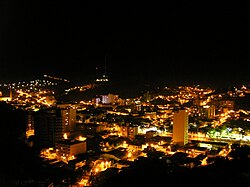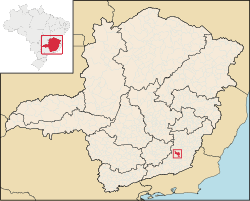Ubá
| Ubá | |||
|---|---|---|---|
| Municipality | |||
| Municipality of Ubá | |||
 |
|||
|
|||
 |
|||
| Location in Brazil | |||
| Coordinates: 21°07′12″S 42°56′34″W / 21.12000°S 42.94278°WCoordinates: 21°07′12″S 42°56′34″W / 21.12000°S 42.94278°W | |||
| Country |
|
||
| Region | Southeast | ||
| State |
|
||
| Established | November 3, 1815 | ||
| Incorporated | July 3, 1857 | ||
| Government | |||
| • Mayor | Vadinho Baião (PT) | ||
| Area | |||
| • Total | 407.7 km2 (157.4 sq mi) | ||
| Elevation | 338 m (1,108.9 ft) | ||
| Population (2012) | |||
| • Total | 104,004 | ||
| • Density | 231.5/km2 (599.6/sq mi) | ||
| • Demonym | Ubaense | ||
| Time zone | BST (UTC-3) | ||
| • Summer (DST) | BDT (UTC-2) | ||
| Postal Code | 36500-000 | ||
| Area code(s) | 32 | ||
| HDI (2000) | 0.773 – medium | ||
| Website | Ubá, Minas Gerais | ||
Ubá is a municipality located in the Zona da Mata mesoregion of Minas Gerais, Brazil, 290.88 kilometers (180.74 mi) southeast of Belo Horizonte, and 284.31 kilometers (176.66 mi) north of Rio de Janeiro. The estimated population of the city of Ubá was 99,708 in 2009. The current mayor of Ubá is Vadinho Baião.
Once a great tobacco producer, Ubá has one of the main furniture industry parks in Brazil. The city is the economic and cultural center of Ubá microregion. It is also home of the famous Ubá mango (Manga Ubá).
The Pomba River basin settlement took place, initially, due to the decline of mining activities. In the late 18th and early 19th century, several families left Mariana, Ouro Preto, and other mining centers in search of fertile land where they could undertake activities that would result in a more stable and secure incoming. The regions bathed by the Itajaí River, Chopotó River, Pomba River, among others, were of great interest because the land in those areas were of great fertility, and that they were previously inhabited only by natives (Coroados, Coropós and Purís) and adventurers.
The attempts of colonization of Coroados, Coropós, Purís and always ended in bloody battles between the true owners of the land and the white invaders. During the battles, using arrows and axes against firearms, the Indians were gradually slaughtered or made prisoners for slave labor, especially when it comes to young people and women.
Due to the international pressure against the genocide of natives, the King of Portugal was convinced to order the Governor Luís Diogo Lobo da Silva to organize an expedition in an attempt to friendly approach the natives. In November 1767, Father Manoel de Jesus Maria was put in charge for the conversion of the natives to Catholicism, laying the groundwork for the entry of the owners of land grants after 1797. Captain Francisco Pires de Farinho, who was familiar with the tracks of forests and the indigenous customs, and was familiar with them, was named special guide with control power.
...
Wikipedia



